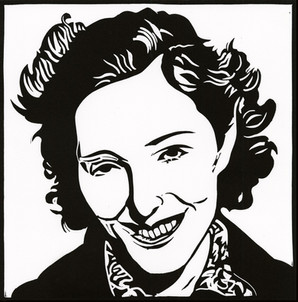Andrzej Klimowski and Danusia Schejbal: Theatre of Dreams at POSK review by Gertrude Gibbons
- gertrudelmgibbons
- Dec 5, 2022
- 5 min read
Theatre of Dreams: Anglo/Polish Cultural Exchange, exhibiting the work of artistic collaborators and married couple Andrzej Klimowski and Danusia Schejbal, ran from 21st October – 18th November 2022. The exhibition formed part of the inaugural Anglo-Polish Cultural Exchange Festival organised by the Polish Social and Cultural Association (POSK) in partnership with Ognisko Polskie (Polish Hearth) and the Polish Cultural Institute in London (PCI), marking the first time these three UK-based Polish organisations have collaborated in this way. The Granville-Skarbek Anglo-Polish Cultural Exchange, as it is titled in full, is named after Krystyna Skarbek, known as Christine Granville, Britain's first female secret agent, active during WW2. Included in the Theatre of Dreams exhibition was a new portrait of Krystyna Skarbek by Klimowski, and a new painting representing Anglo-Polish relations by Schejbal.
There is an atmosphere of night in the exhibition 'Theatre of Dreams'. My mind heard Demetrius' lines in A Midsummer Night's Dream:
Are you sure That we are awake? It seems to me That yet we sleep, we dream.
By the end of the play, the suggestion is that it has all been a series of visions appearing within a dream; the theatre has embraced the audience in a united dream.

Danusia Schejbal. Anglo-Polish Cultural Exchange. Oil on canvas, 2022.
The central painting forming the background image announcing the 'Theatre of Dreams', shows a standing lion with its paw meeting the wing of a standing eagle. The work represents a meeting of England (the lion) with Poland (the eagle). Dark blue curtains reveal this exchange, as though on a stage, the animals playing the parts of their countries and cultures. The viewer is invited to enter the exhibition with these curtains ahead of them, as an audience to the exchange, a witness to the dream. Perhaps it is the blue of this work that sets the space's atmosphere to resonate with night, and the use of animals standing upright like actors, that evokes mystery and magic. This resounds in Schejbal's 'real' costume designs for Macbeth which draw out the supernatural, magic and madness of the play itself. The luminous white of the birds as ballet dancers in another painting by Schejbal adds to the evocation of night, like moonlight at the forefront of the dark stage. With the slight blur to the brushstrokes, the sense of dreaminess is strong.
Opposite the door into the gallery, two eyes look out directly at the viewer. As two figures in profile appear to kiss across and within some kind of wall or frame, their eyes are directed outwards towards the viewer. This screenprint photomontage Synapse (1983) by Klimowksi, is a portrait of Klimowski and Schejbal. Their eyes, meeting in the centre, are framed in such a way that they become their own face with eyes masked in the manner of masquerade. We are invited to witness the spectacle and meet the gaze of the work.
The approach throughout the exhibition to space and the framing of space is striking. In Synapse, frames do not appear to restrict, but perform as another element to the image, indicating sections of the work that may be read independently, or as lines that are guiding a reading of the work as a connected whole. Klimowski's covers for Harold Pinter's plays published by Faber & Faber seem as though they have been extracted from a larger picture, and are not contained by the space of the page. Schejbal's paintings of stages appear to frame a whole picture, with their subjects largely in the centre, but are depicted as though caught in motion; the legs of the birds elegantly in the middle of walking across the stage. An untitled painting (mixed media on linen on board) shows a woman with fiery red hair in a leotard standing in contrast with the dark uniformly dressed people in the background. She appears in complete control of her encounter with a figure in uniform. Her posture and appearance is otherworldly, and as though she is about to walk directly out of the work. She is like a figure standing apart in a dream, the figure remembered upon waking while the rest fades into the background. Walking out of the painting, she crosses the border of dream states into the audience's waking world.
Andrzej Klimowski, linocuts (series of 6), 2022. Above: Christine Granville aka Krystyna Skarbek, Joseph Conrad, Sir Andrzej Panufnik.
The backgrounds of the linocuts created this year by Klimowski suggest further spaces and worlds opened by the portraits of Anglo-Poles they depict. Each portrait background is different, and there seem subtle references to their subject's work, like the sea behind Joseph Conrad pointing at his maritime background and writing, and the musical score behind Sir Andrzej Panufnik, a conductor and composer. The only background that is blank is for Krysyna Skarbek, perhaps suggesting her silence as a secret agent, and also allowing her face to stand apart for this Exchange that has been named after her.
The exhibition's curation was refreshing, unclustered in a way that allowed the figures within these works to step beyond their frames and invite the viewers' collaboration in the 'theatre of dreams'. The vitrines displaying books show the importance of the book form in this couple's collaboration, and recall Klimowski and Schejbal's statement: ‘We both worked as designers for leading theatres in Poland but on our return to the UK we moved towards painting, illustration and publishing graphic novels.’ The display incorporates the various areas of the couple's history of collaboration across English and Polish cultures and experience. The invitation here appears to be towards the meeting of minds, nations, people and sharing of cultures and ideas. The theatrical sense of staged and framed dream states is powerful and inviting of audience imagination and participation, an optimistic launch for the cultural exchange.
Installation images of Andrzej Klimowski and Danusia Schejbal: Theatre of Dreams at POSK, London.
*
The Skarbek-Granville Anglo-Polish Cultural Exchange is being led by the Project Curator Julia Griffin and Elvira Olbrich, POSK Arts Director.Project Curator Julia Griffin says: ‘Our project builds on the great interest in the Anglo-Polish cultural links explored in the Young Poland exhibition. The Anglo-Polish Cultural Exchange will double as a cultural and social campaign. Telling our shared history of Anglo-Polish heritage, it aims to create relevant and relatable content for Britain’s diverse audiences whilst countering stereotypes.’ It is delivered in close collaboration with Ognisko Polskie’s Ania Mochlińska-Rakowicz (Vice-Chairman) and her project team, and with the Polish Cultural Institute’s Dr Marta De Zuniga (Director) and Natalia Puchalska (Head of Education, Literature and Communications). The aim of the Exchange, constituting an online museum and research hub with a series of exhibitions and events, is to have it develop into a permanent physical museum located at POSK. The idea for the museum has been instigated by Dr Marek Laskiewicz, Chairman of POSK. Established in 1964 when Poland was under the Soviet rule, its notable avant-garde brutalist premises designed by M. F. Grzesik in 1971, POSK is the largest Polish Cultural Centre in the world outside Poland.
Images courtesy the artists.














Comments